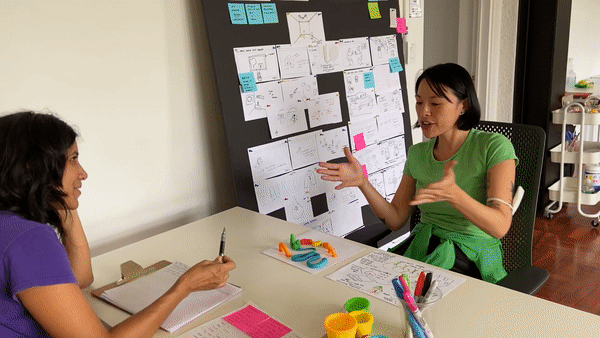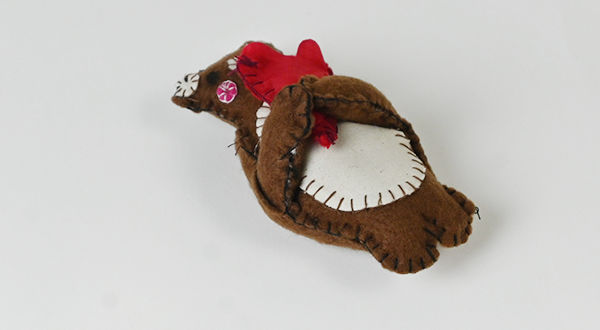‘my zemi’ for trauma therapy
Design research | concept | prototyping
Masters Thesis Project, Copenhagen Institute of Interaction Design (CIID), 2021
Trigger warning: This project has graphic accounts of trauma
Language clarification: The term ‘safe space’ has since been replaced and used interchangeably with ‘safe state’ by those in the trauma therapy community.
Challenge
We are facing a mental health epidemic; more than half of all humans experience at least one trauma in their lives. Trauma is the lasting emotional response that results from living through a distressing event. Experiencing trauma can harm a person’s sense of safety, sense of self, and ability to regulate emotions and navigate relationships. The American Psychiatric Association defines PTSD (Post Traumatic Stress Disorder) as a psychiatric disorder that may occur in people with trauma. With early intervention, PTSD can be successfully prevented, with lasting effects on individual’s lives and entire communities.
Context
Early in graduate school, I witnessed my husband’s sudden death. This led me down a personal journey navigating grief, trauma, and PTSD. I sought EMDR (Eye Movement Desensitization and Reprocessing) trauma therapy, which was miraculous in my healing. Causing me to research EMDR science, connect with a community of practitioners and patients, and discover opportunities for design interventions to improve the patient experience. Which formed the basis of this 2 month thesis project.
Outcome
My Zemi is a trauma therapy toolkit for use in large scale humanitarian crises. Developed with guidance from EMDR Humanitarian Assistance Program, My Zemi offers a low-cost/high-touch solution for therapists. Creation of and easy access to a ‘safe space’ is the gateway to effective treatment in EMDR therapy. How might we equip clinicians to help patients create and access imaginary safe spaces in order to motivate them to be more receptive to EMDR therapy?
My Zemi toolkit is used by therapists and patients to create a visual and physical 'safe space'.
My Zemi has been positively received by the EMDR community, with an informal invite to present it at their next conference. I am also in talks with EMDR HAP, Ethiopia to potentially pilot test My Zemi on the ground there.
“We don’t respond to what happens. We respond to our perception of what happens. That’s what trauma is. We don’t respond to the moment. We respond to the past.”
What is EMDR trauma therapy?
Demonstration of how EMDR works
Influential figures like Prince Harry have popularized EMDR by sharing about their experiences on national television
Research
For field research, I used social media to recruit from the grief communities I had joined after my husband’s death.
I had concerns about the research process given the sensitivity of the subject and was overwhelmed by the responses from the community.
I recognized and was grateful for access and acceptance from my research participants on account of my lived experience.
I conducted over 20 hours of interviews over the course of 8 weeks with 17 participants in 6 countries. Speaking with clients/patients, therapists/clinicians and analogous research participants across USA, Canada, Costa Rica, Venezuela, UK, Netherlands, and Qatar. The participants ranged from victims of trauma/PTSD/depression/anxiety, EMDR therapists, EMDR academics, psychotherapists, mixed reality experts in medical innovation, futurists and even a spiritual medium!
There were 3 main themes to my research:
Client experience
Therapist experience
Use of Mixed reality in mental health diagnosis and treatment
“I’m impressed by the way you’ve gathered and distilled information, and by the focus you hold in helping others. The issues you’ve isolated as challenges to broader use and effectiveness are also, as you reframe, opportunities…Your questions have left me thinking of a number of directions and options. This feels like the beginning of a bigger and ongoing conversation that I’m happy to be involved in.”
Key Insight #1
A clinician’s ability to help patients use their imagination to create safe spaces is critical to patients’ willingness to participate in EMDR therapy.
Key Insight #2
Creation of and easy access to a ‘safe space’ is the gateway to effective treatment in EMDR therapy.
“A safe space or safe state may be thought of as an emotional sanctuary where a person can internally go to recover stability when feeling stressed.”
Opportunity
I established parameters for design principles based on my learnings from research. The solution would need to be meaningful in terms of real impact on an individual level, not just at a system level. I realized my original intentions of using immersive technology, while well intended, would be inaccessible to the vast majority of EMDR practitioners and patients. Clinicians in developing countries spend upwards of $1000 per year on required training and certification. They were not keen on an additional expense, which would be a deterrent not only to them but also their patients whom the cost would eventually be passed down to.
Recognizing that technology can be intrusive and self gratuitous, I decided to exercise restraint in its use in my design.
I chose to focus on accessibility, impact at scale and early intervention on site (especially in large scale humanitarian crisis situations like school shootings and natural disasters).
My constraints were informed by the many clinicians I spoke with, who expressed the need for inexpensive, resourceful tools that were preferably sensorial and high touch.
Mind maps of purpose and properties of the solution
Competitor Analysis
An analysis of the market for EMDR tools revealed that there is currently no product in the market that is low cost (sub $50 price point) and high touch.
Products can be broadly grouped into 2 categories:
EMDR tools for use in a therapist’s office
Mobile app based solutions for use at home by clients
I discovered white space for a solution that has the potential to bridge the gap between what happens at the clinician’s office and at the client’s home. Reducing the intake time at each therapy session and offering clients continuous support between sessions.
Sketching & Ideation
My initial ideation covered the below key ideas:
Immersive technology
Self expression environments
Sensory tools
Making memories tangible
Sustainable treatment strategies
Testing
I ran many rounds of ideation, and prototyped and tested several low to mid-fidelity versions:
An app that creates a montage of a client’s safe space that may then be 3D printed into a keepsake
A safety blanket with sensory inputs and physiological monitors
A machine learning based software that uses AI to aid with creative visualization of a safe space
An art therapy kit for safe space creation
Learnings from Testing
I was unable to test with actual patients due to limitations in time and need to meet HIPAA privacy requirements.
So I recruited participants from within my program, friends & family and clinicians.
The most effective tool was also the simplest! Most participants found the art therapy based exercise to be tremendously therapeutic. Using a combination of media - writing, drawing and sculpting, they were able to elicit positive memories and capture them in delightful ways.
Drawing was the closest to visual memory, but writing helped capture details and sculpting helped abstract visuals.
All participants loved the idea of creating a keepsake, a totem that represented their safe space.
Some takeaways
“I felt like I was journeying through different memories.”
“Thanks for giving me back five years of my life!”
“The process made me sentimental…I feel more connected (to my life).”
Thus was born the final idea for the concept.
A Totem.
My Zemi (Afro-Caribbean for totem) is an art therapy toolkit that comes with instructions for steps to create a safe space, air dry clay in six colors and sculpting tool, and fun shapes template. All materials are eco-friendly and compostable.
Instruction sheet for clinicians or aides (at humanitarian crisis sites) to use while guiding patients to creation of their safe space.
Key Moments in User Experience
Key Moment 1
Step between Key Moments 1 & 2
WORK IN PROGRESS
Key Moment 2
When stressed/triggered, client reaches for connected Zemi
As they hold the Zemi, it walks them through a breathing exercise and monitors their heart rate
When optimal heart rate is reached, Zemi glows to indicate its ok to access mental safe space
Next Steps
I’m currently investigating the below:
Longitudinal field study with EMDR HAP therapists and clients
How will the connected Zemi improve the therapist-client experience?
What is the kind of data that would be useful to improve the user experience?
How to mitigate privacy concerns?
Impact
Lori Pereira, Therapist/Expert, EMDR Humanitarian Assistance Program
Joshua Tercero, CIID, IDP 2021 classmate
























